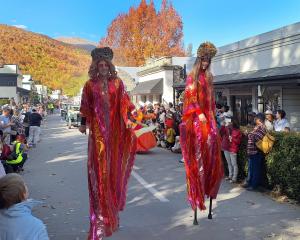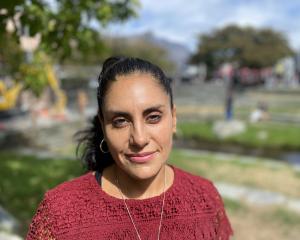Lindsay Kennett spoke to the Otago Daily Times on the occasion of a double retrospective exhibition at the Lakes District Museum and Gallery - "Lindsay Kennett: A Life in Art and Fashion". The show runs until April 18.
"For some unknown reason, I became passionately fascinated by fashion when I was 8 or 9," Mr Kennett said.
"I'd draw clothes all the time, but the only fashion we saw were smart formal people on excursions, disembarking the Earnslaw to go to Paradise.
Ladies wrapped in furs, men in trilby hats, suits and ties to the beach."
"A Life in Art and Fashion" features two dozen hats Mr Kennett reproduced and created to illustrate the changing styles of 20th-century fashion, from 1910 to 1970.
Mr Kennett debuts 60 of the fashion illustrations he created for himself and other designers as advertising.
About two dozen watercolours on paper and mixed media of flower paintings and landscapes of the Southern Lakes attest to his love of art.
International media clippings of his career since 1957 are on display.
A section of the showcase is devoted to his on-location paintings of tropical plants from when he joined a Ministry of Foreign Affairs-sponsored workshop on Niue Island.
The mission was to establish an export business for woven pandanus hats.
A pictorial record of the project in 1997 accompanies his paintings.
"They were making a crown and brim, which was no different from anyone else, so I had to put the element of high fashion into what they were doing, while keeping the indigenous techniques.
"The outcome was an anticlimax. Not long after, the drawings and hat blocks were destroyed and swept away by a cyclone."
The hats on view from his historic collection of 130 illustrate how trends in millinery reflected changes in the world during the past century.
The Edwardian hats of 1910 were "large-brimmed and ostentatious" but largely disappeared by the end of World War 1 for more practical styles, he said.
"Fashionable women had their hair bobbed in the 1920s and milliners designed hats over their hair, with the brim down to brow level, which give women a snooty look, because to anything they had to look down their noses.
"In the 1930s, hats became small and moved so far forward on the head they were designed with a band on the back to stop them falling off. It was also a time when Hollywood talking pictures came in with a burst and a lot of movies were elaborately costumed, including hats, to lighten mood of the Depression.
"From 1935, hats were worn prolifically and in the late 1930s, my favourite fashion period, Hollywood made people want to be like film stars, so much so they wanted to copy what they wore.
"I've had customers as late as the 1960s say they want a very elegant and casual hat like Carole Lombard's."
Austerity returned with World War 2 and little fashion news came from France due to its occupation by Nazi Germany, Mr Kennett said.
"That's when milliners almost stole the crown from the French, with their very glamorous, morale-boosting hats.
"After the war, Christian Dior showed a new look with bouffant shirts, little jackets and nipped-in waists. The crown was snatched back and France remains the greatest fashion influence in the world."
Mr Kennett said he did not think there was much inspiration with hat style in the late 1950s, although designer Hubert de Givenchy changed fashion again.
"His clothes demanded a heavier hat, more voluminous, worn at eye level. I had to use cake tins as hat stocks.
"The heavier look remained until the beehive hairdos of the 1960s and milliners were again on the defensive, making hats that covered that hair all over. But it really was the end of the millinery trade."
Everything went against milliners with the advent of casual clothes, trouser suits, wigs and no hats in church, Mr Kennett said.
The Royal Family's fondness for hats and their influence kept the trade alive, he said.
"I was very fortunate to keep going because I only employed up to six people and I was in a wholesale business and hat boutique."
Many firms wanted to retail his hats exclusively, but he said he always heeded the advice of a warehouse man in the early 1950s - "Never put all your eggs in one basket" - and concentrated on working both New Zealand and Australian markets.
Mr Kennett was born in the historic Stone House in 1928, when the still-surviving Queenstown building was a nursing home.
His formative years were spent with his parents at Rees Valley Station, at the head of Lake Wakatipu.
The family left Glenorchy in 1940 so Mr Kennett and his brother could attend secondary school in Dunedin.
Based in the city for 10 years, he studied at the Dunedin School of Art, from 1943 to 1948.
"It was marvellous to be taught by J.W. Reed, and Robert Boyd, who was a great influence on me and art in general."
He worked as a sales assistant in the fabric department of Arthur Barnett and learned about fabrics in the department store.
He was a freelance fashion drawer for an advertising agency, until he was told to aim for the fashion centres of New Zealand, Wellington and Auckland.
The first hat Mr Kennett made was in 1951, when he was working as a window dresser in Kirkcaldie and Stains, in the capital.
Hat design fascinated him and he thought he could make one, so he bought material and a hat block and showed the finished product to the revered department store's buyer of hats.
"She said, 'If you're making any more, I will buy them on the spot'. I was making hats for Kirkcaldies until 1995."
The self-described "grumpy old bachelor" retired to Dunedin in 1990, after working for most of his 40-year career in Auckland.
While he gives historical fashion talks for charities and service organisations and paints, he is still in regular contact with clients around the world and fulfilled an order placed by women heading for a day at the Ascot races.
A black pillbox hat designed, made, decorated and veiled by Mr Kennett would cost $350.
A unique custom-made, pure silk hat, complete with expensive trimmings of French silk flowers made especially for the fashion trade, would cost $600.
One of his $350 hats was won in a raffle by Arrowtown resident Jocelyn Robertson, during the exhibition launch, on February 11.
About 140 people attended and funds from the draw will go towards the museum.
A second hat will be won by a New Zealand resident who buys a raffle ticket while the exhibition runs.
The winner's name will be announced at its close.
"There are still people who wear hats, but it's not the industry it was," Mr Kennett said.
"There's a demand for haute couture hats from wealthy clients and a demand for practical hats, which I don't do."












